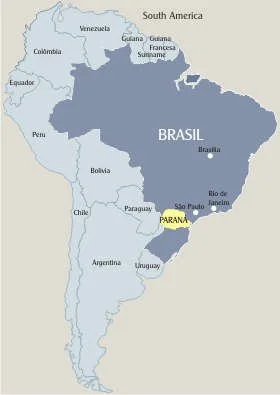Vou dizer pra minha mulher, Paraná
Capoeira que venceu, Paraná
Paraná ê, Paraná ê, Paraná
Ela que bateu o pé firme, Paraná
Isso não aconteceu, Paraná
Paraná ê, Paraná ê, Paraná
É de vera que o morro, Paraná
Se mudou para a cidade, Paraná
Paraná ê, Paraná ê, Paraná
Tem batuque todo dia, Paraná
Mulata de qualidade, Paraná
Paraná ê, Paraná ê, Paraná
Minha mae e mulher velha, Paraná
Fecha porta e dorme cedo, Paraná
Paraná ê, Paraná ê, Paraná
A mulher para ser bonita, Paraná
Nao precisa se pintar, Paraná
Paraná ê, Paraná ê, Paraná
A pintura é do Diablo, Paraná
A beleza e Deus quem da, Paraná
Paraná ê, Paraná ê, Paraná
Vou me embora, vou me embora, Paraná
Como eu já disse que vou Paraná
I’ll tell my wife, Paraná
That Capoeira won, Paraná
Paraná ê, Paraná ê, Paraná
She stomped her foot firm, Paraná
That it did not work, Paraná
Paraná ê, Paraná ê, Paraná
And to see that the hill, Paraná
Surrounds the city, Paraná
Paraná ê, Paraná ê, Paraná
Have drumming all day, Paraná
brown women of quality, Paraná
Paraná ê, Paraná ê, Paraná
My mother and old woman, Paraná
Close the door and go to sleep early, Paraná
Paraná ê, Paraná ê, Paraná
The woman that is beautiful, Paraná
Does not need to paint (herself), Paraná
Paraná ê, Paraná ê, Paraná
Painting is of the Devil, Paraná
God gave beauty, Paraná
Paraná ê, Paraná ê, Paraná
I’m leaving, I’m leaving Paraná
Like I said I’ll go Paraná
There are several versions of this song and several interpretations of its meaning.
Etymologically, the word Paraná comes from the indigenous Tupi Guarani langage and means “Like the sea/As big as the sea”.
Paranauê is a contraction of Paraná with the Tupi Guarani greeting Auê.
O Río Paraná is a huge river in South America which crosses Brazil, Argentina and Paraguay, forming the border between the latter two countries. It is the second largest river in South America after the Amazon.
This river has special significance for capoeira, due to the Paraguayan War 1864 to 1870 which was one of the largest and bloodiest wars of South American history, fought between the triple alliance of Brazil, Aregenina and Uruguay, against Paraguay.
Brazil sent many slaves to fight in the war with Paraguay, promising that when (if) they returned they would be emancipated and could live as free men.
The war began in 1865 and lasted five years. At the time, Paraguay was the only country in Latin America that could be considered independent, and it found itself in full industrial development, with weapons and gunpowder factories. Unproductive land was being transformed into state plantations, generating employment for the whole population. Impeding the process of Paraguay was a big challenge for England, because Paraguay became a big competitor in productivity. Brazil and Argentina, on the other hand, were interested in taking possession of parts of Paraguayan land. The spark that initiated the war occurred on November 24, 1864, when Paraguayan president Solano López cut ties with Brazil, captured the Brazilian ship Marques de Olinda, and invaded the state of Mato Grosso (which, together with Paraná, are the only states that border Paraguay). At the end of all the battles, the Paraguayans took the worst casualties. 75% of the country’s population was killed; of 800,000 inhabitants, only 194,000 were left. With this victory, England once again returned to economic domination of the region, and Brazil and Argentina managed to take 140,000 kilometers of the land they wanted.
The whites “logically” didn’t want to be on the front line of battle, so they created a law saying that blacks who entered the war and returned alive would win their liberty. What the whites didn’t anticipate was that the majority of the blacks who went actually returned.
Those lucky enough to survive the war returned to Brazil from Paraguay following the River Paraná, and sang the song in celebration. Many of fighters accredited their survival to having trained capoeira.




